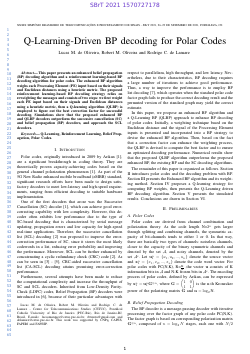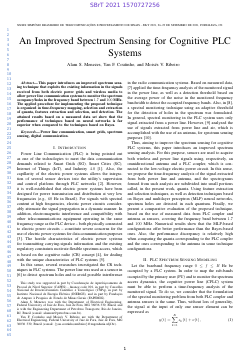
XXXIX Simpósio Brasileiro de Telecomunicações e Processamento de Sinais

Q-Learning-Driven BP decoding for Polar Codes
Lucas M. Oliveira, Robert Mota Oliveira, Rodrigo C. de Lamare
DOI: 10.14209/sbrt.2021.1570727178
Keywords: Q-Learning Reinforcement Learning Belief Propagation Polar Codes
Abstract
This paper presents an enhanced belief propagation (BP) decoding algorithm and a reinforcement learning-based BP decoding algorithm for polar codes. The enhanced BP algorithm weighs each Processing Element (PE) input based on their signals and Euclidean distances using a heuristic metric. The proposed reinforcement learning-based BP decoding strategy relies on reweighting the messages and consists of two steps: we first weight each PE input based on their signals and Euclidean distances using a heuristic metric, then a Q-learning algorithm (QLBP) is employed to figure out the best correction factor for successful decoding. Simulations show that the proposed enhanced BP and QLBP decoders outperform the successive cancellation (SC) and belief propagation (BP) decoders, and approach the SCL decoders.Download

Projeto em FPGA de um Filtro Digital FIR do Tipo Sinc-Janelado Utilizado na Tecnologia F-OFDM
Maykon Renan Pereira da Silva, Flávio Geraldo Coelho Rocha, Patrick Teles
DOI: 10.14209/sbrt.2021.1570727211
Keywords: F-OFDM FPGA Filtro Sinc-Janelado OOBE
Abstract
Este trabalho tem como objetivo apresentar a implementação de um algoritmo de processamento digital de sinais em um FPGA (Field-Programmable Gate Array) utilizando a placa de desenvolvimento Altera DE0. O algoritmo implementado é o de filtro digital do tipo Resposta ao Impulso Finita (FIR - Finite Impulse Response), mais especificamente um filtro sinc-janelado, cujo protótipo baseia-se em uma função sinc no domínio do tempo, com o intuito de obter uma resposta ideal retangular no domínio da frequência. Para tornar o filtro realizável e ao mesmo tempo eficiente, essa função sinc é multiplicada por uma função de janela propriamente escolhida para prover resultados de interesse tanto no domínio do tempo, quanto no domínio da frequência, o que inclui a análise da Interferência Inter-Simbólica (ISI - Intersymbol Interference) e Emissão Fora de Banda (OOBE - Out-Of-Band Emission). O filtro implementado pode ser utilizado na Modulação por Divisão Ortogonal de Frequência Filtrada (F-OFDM - Filtered Orthogonal Frequency-Division Multiplexing), uma tecnologia candidata a ser utilizada nas redes de comunicações móveis de quinta geração (5G), e consiste basicamente na aplicação de filtros nas sub-bandas do sistema OFDM convencional.Download

Estrutura de rede quincunce em sistemas QAM-FBMC com filtros curtos
Iandra Galdino, Didier Le Ruyet, Marcello Campos, Rostom Zakaria
DOI: 10.14209/sbrt.2021.1570727217
Keywords: Banco de filtros QAM-FBMC rede quincunce estrutura de rede
Abstract
Quadrature Amplitude Modulation Filterbank Multicarrier (QAM-FBMC) has been a promising technology for 5G communication systems. However, to achieve the desired performance, it is necessary to deal with the intrinsic interference observed at the receiver. Aiming to overcome the intrinsic interference, in this paper, we evaluate the applicability of a quincunx lattice structure to the QAM-FBMC systems implemented with short filters. We compare and analyze the performance of the QAM-FBMC with rectangular and quincunx lattice structures through the bit error rate (BER) over AWGN and pedestrian fading channels.Download

Previsão de Casos de COVID-19 no Brasil com Aprendizagem de Máquina Automatizada
Leticia Mendes, Elloá Guedes
DOI: 10.14209/sbrt.2021.1570727222
Keywords: Aprendizagem de Máquina Séries Temporais COVID-19
Abstract
O presente trabalho considera a utilização de Aprendizagem de Máquina Automatizada para investigar o problema da previsão de novos casos de COVID-19 no Brasil com uma semana de antecedência. Utilizando uma abordagem de programação genética e validação cruzada do tipo Time Series Split, foi possível obter um regressor por Vetores de Suporte Linear para esta tarefa, com capacidade de melhorar suas previsões conforme a evolução da pandemia.Download

O Efeito da Digitalização num Sistema de Comunicação Baseado em Sincronismo Caótico
Vinicius Silva Borges, Marcio Eisencraft
DOI: 10.14209/sbrt.2021.1570727244
Keywords: Sistemas de Comunicação Erro de digitalização Sincronismo Caóticos
Abstract
A dinâmica caótica pode ser explorada para a implementação de sistemas de comunicação não convencionais. Uma das formas de fazê-lo consiste em utilizar o sincronismo que ocorre entre osciladores caóticos, para transmitir informações adequadamente codificadas dentro do conjunto invariante. Sendo assim, no decorrer das últimas décadas, muitos métodos de sincronismo para sistemas caóticos têm sido propostos visando aplicações em comunicações. No entanto seus desempenhos não têm se mostrado satisfatórios quando submetidos a condições praticas de transmissão. Dessa forma, neste trabalho faz-se uma análise simplificada da influência do erro de digitalização no desempenho de um sistema de comunicação baseado em sincronismo caótico.Download

Antena de Fibra Óptica Plástica como Detectora em Enlaces LiFi
Juliana De Paula, Ricardo Marques Ribeiro, Claudia Barucke Marcondes, Maristela Ciara, Vinicius Silva
DOI: 10.14209/sbrt.2021.1570727245
Keywords: Visible Light Communications Scattering Plastic Optical Fiber Fluorescence
Abstract
This article presents the development of a device that works as a light detector in the visible range, an "optical antenna". The idea is to use a small segment of plastic optical fiber (POF) made from PMMA or fluorescent polystyrene in LiFi (Light Fidelity) systems.Download

Transformada de Hilbert-Huang Modificada com Redução do Ruído para Sinais de Sonar Passivo
Elio Sarno Filho, Anderson Santos, Eduardo Simas Filho, Antonio Carlos Lopes Fernandes Junior, José de Seixas
DOI: 10.14209/sbrt.2021.1570727247
Keywords: HHT EMD SONAR passivo ACF
Abstract
The Hilbert-Huang transform (HHT) is a time-frequency (TF) analysis technique based on empirical mode decomposition (EMD), which has been successfully applied to non-stationary signals and non-linear systems, including passive SONAR signals. However, the performance of HHT/EMD can be greatly degraded under conditions of low signal-to-noise ratio (SNR). The present work proposes a TF analysis method for passive SONAR signals based on HHT/EMD, in which noise reduction is performed by analyzing the autocorrelation function (ACF) and the wavelet threshold denoising (WTD), performed after EMD. The results obtained with experimental passive SONAR signals are used to validate the proposed method.Download

An Improved Spectrum Sensing for Cognitive PLC Systems
Alam Menezes, Yan F Coutinho, Moises Vidal Ribeiro
DOI: 10.14209/sbrt.2021.1570727256
Keywords: Power line communication smart grids spectrum sensing digital communication
Abstract
This paper introduces an improved spectrum sensing technique that exploits the existing information in the signals received from both electric power grids and wireless media to allow power line communication systems to monitor the spectrum occupancy/holes in the frequency band between 1.7 and 100 MHz. The applied procedure for implementing the proposed technique is organized in time-frequency mapping, selection and extraction of quanta, features extraction and selection, and detection. The attained results based on a measured data set show that the performance of techniques based on neural networks is far superior when compared to the techniques based on Bayes.Download

Economical Benefits of Energy Recovery from the Undesirable Components of Electric Signals
Nathan Cravo, Moises Vidal Ribeiro, Victor Fernandes, Henrique Luis Monteiro
DOI: 10.14209/sbrt.2021.1570727268
Keywords: waste-to-energy energy recovery power quality electric power systems
Abstract
This paper introduces a practical approach to analyze and quantify the benefits of using the waste-to-energy concept to improve power quality and energy efficiency in electric power systems. Also, we introduce the so-called Passive Filtering Energy Recovery, which aims to perform the energy recovery in undesirable components present in electric signals. Finally, numerical results show that this approach can improve power quality and energy efficiency in the Brazilian scenario.Download

Conversão Texto-Fala para o Português Brasileiro Utilizando Tacotron 2 com Vocoder Griffin-Lim
Rodrigo K Rosa, Danilo Silva
DOI: 10.14209/sbrt.2021.1570727280
Keywords: Redes neurais Síntese de voz Tacotron 2 Português brasileiro
Abstract
This paper presents the training of a state-of-the-art neural network model, Tacotron-2, using a open-source voice dataset from the Common Voice project. Results from training the model from scratch and by applying transfer learning of a pre-trained english model were evaluated. The results show that it is possible to train the model with limited data resources and the model trained from scratch had less synthesis errors.Download